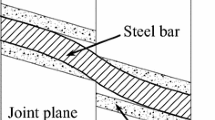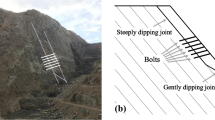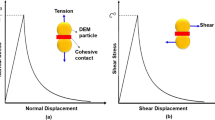Abstract
Pre-tensioning of rockbolts is permitted to ensure better confinement between bedding rock slopes. The resulting shear adherence between layers is then increased, and a resistance against the rock block’s movement is developed. This paper develops a simple analytical approach to better understand the performance of pre-tensioned grouted rockbolts in bedding rock slopes. The force method approach and the deformation compatibility principles are used to model the contribution of developed axial and shear bolt forces at the intersection between the bolt and the joint plane to evaluate the behavior of the rockbolt in the elastic state. The effects of the pre-tension, the joint roughness, bolt inclination with respect to the joint plane, and rock strength are investigated, and the influence of the bolt contribution to preventing rock layer sliding is discussed. Furthermore, a 3D numerical approach is used to study the bolt performance in a plastic state. The results show that when the bolt is completely perpendicular to the discontinuity, the lower bolt contribution is generated. The pre-tensioning and joint roughness caused an improvement in resistance at the joint due to the utilization of the bolt axial capacity. Besides, the pre-tensioned rockbolt will be more useful for high-strength rock slopes.



















Similar content being viewed by others
Abbreviations
- 2lp :
-
The deflecting length of the bolt
- A :
-
The cross-sectional area of the bolt
- fy :
-
The yield strength of the bolt
- T :
-
The pre-tensioned load
- No :
-
The axial force acting in the bolt at the intersection between the bolt and the joint plane
- Qo :
-
The shear force acting in the bolt at the intersection between the bolt and the joint plane
- X1, X2, X3:
-
The axial force, shear force, and bending moment acting at the beam end
- \({\sigma }_{c}\) :
-
The uniaxial compressive strength of the rock/grout
- \({\Delta }_{1},{\Delta }_{2},{\Delta }_{3}\) :
-
The axial displacement, shear displacement, and rotation angle at beam end
- \({\delta }_{ij}\) :
-
The displacement of the primary structure due to unit primary unknowns
- E :
-
The Young’s modulus of the bolt
- G :
-
The shear modulus of the bolt
- μ :
-
The Poisson’s ratio of the bolt
- I :
-
The moment of inertia of the bolt
- κ :
-
The shearing-shape coefficient of the bolt
- qo :
-
The maximal collection degree of the compressive load
- u, v :
-
The opening and shear displacements
- i :
-
The dilation angle of the joint
- K :
-
The bolt coefficient
- α :
-
The angle of the bolt with respect to the joint plane
- r :
-
The rockbolt cross section radius
- \({\phi }_{r}\) :
-
The residual friction angle of the joint plane
- JRC :
-
The joint roughness coefficient
- JCS :
-
The compressive strength of the rock at the fracture surface
- sl, st :
-
The longitudinal and transverse distances of bolts in a block
- \({\sigma }_{n}\) :
-
The effective normal stress
- R Q,R N,R T :
-
The contributions to support force against sliding along the joint provided by the shear, axial, and pre-tensioned forces in the bolt at the intersection between the bolt and the joint plane, respectively
- γ :
-
The mass density
- db :
-
The diameter of the bolt steel
- N q(x),Q q(x),M q(x):
-
The axial force, the shear force, and bending moment equations, respectively
References
Aziz N, Craig P, Mirzaghorbanali A, Nemcik J (2016) Factors influencing the quality of encapsulation in rock bolting. Rock Mech Rock Eng 49(8):3189–3203
Barton N (1973) Review of a new shear-strength criterion for rock joints. Eng Geol 7(4):287–332
Barton N, Bandis S, Bakhtar K (1985) Strength, deformation and conductivity coupling of rock joints. Int J Rock Mech Min Sci Geomech Abstr 22(3):121–140
Barton N, Choubey V (1977) The shear strength of rock joints in theory and practice. Rock Mech 10(1–2):1–54
Bi J, Luo X, Zhang H, Shen H (2019) Stability analysis of complex rock slopes reinforced with prestressed anchor cables and anti-shear cavities. Bull Eng Geol Environ 78(3):2027–2039
Bjurstrom S (1974) Shear strength of hard rock joints reinforced by grouted untensioned bolts. Proc 3rd Cong ISRM Denver 2:1194–1199
Cao C, Nemcik J, Aziz N, Ren T (2013) Analytical study of steel bolt profile and its influence on bolt load transfer. Int J Rock Mech Min Sci 60:188–195
Chen N et al (2018) Shear behavior of rough rock joints reinforced by bolts. Int J Geomech 18(1):0401713
Deb D, Das KC (2011) Enriched finite element procedures for analyzing decoupled bolts installed in rock mass. Int J Numer Anal Methods Geomech 35(15):1636–1655
Deb D, Das KC (2014) A new doubly enriched finite element for modelling grouted bolt crossed by rock joint. Int J Rock Mech Min Sci 70:47–58
Dight PM (1982) Improvements to the stability of rock walls in open pit mines. Monash University, Melbourne
Ferrero AM (1995) The shear strength of reinforced rock joints. Int J Rock Mech Min Sci Geomech Abstr 32(6):595–605
Grasselli G (2005) 3D behaviour of bolted rock joints: experimental and numerical study. Int J Rock Mech Min Sci 42(1):13–24
Hutchinson D, Falmagne V (2000) Observational design of underground cable bolt support systems utilizing instrumentation. Bull Eng Geol Environ 58(3):227–241
Hibbeler RC (2012) Structural analysis, 8th edn. Pearson Prentice Hall, New Jersey, p 375
Jalalifar H, Aziz N (2010a) Analytical behaviour of bolt–joint intersection under lateral loading conditions. Rock Mech Rock Eng 43(1):89–94
Jalalifar H, Aziz N (2010b) Experimental and 3D numerical simulation of reinforced shear joints. Rock Mech Rock Eng 43(1):95–103
Li C, Stillborg B (1999) Analytical models for rock bolts. Int J Rock Mech Min Sci 36(8):1013–1029
Li C, Wu J, Wang J, Li X (2016) Layout and length optimization of anchor cables for reinforcing rock wedges. Bull Eng Geol Environ 75(4):1399–1412
Liu C, Li Y (2017) Analytical study of the mechanical behavior of fully grouted bolts in bedding rock slopes. Rock Mech Rock Eng 50(9):2413–2423
Liu C, Li Y (2020) Predicting the shear resistance contribution of passive fully grouted bolts to jointed rock. Int J Geomech 20(2):04019174
Martín LB, Tijani M, Hadj-Hassen F, Noiret A (2013) Assessment of the bolt-grout interface behaviour of fully grouted rockbolts from laboratory experiments under axial loads. Int J Rock Mech Min Sci 63:50–61
Mohammadi M, Hossaini MF, Bagloo H (2017) Rock bolt supporting factor: rock bolting capability of rock mass. Bull Eng Geol Environ 76(1):231–239
Nemcik J, Ma S, Aziz N, Ren T, Geng X (2014) Numerical modelling of failure propagation in fully grouted rock bolts subjected to tensile load. Int J Rock Mech Min Sci 71:293–300
Oreste P, Cravero M (2008) An analysis of the action of dowels on the stabilization of rock blocks on underground excavation walls. Rock Mech Rock Eng 41(6):835–868
Pellet F, Egger P (1996) Analytical model for the mechanical behaviour of bolted rock joints subjected to shearing. Rock Mech Rock Eng 29(2):73–97
Ranjbarnia M, Fahimifar A, Oreste P (2016a) Practical method for the design of pretensioned fully grouted rockbolts in tunnels. Int J Geomech 16(1):04015012
Ranjbarnia M, Oreste P, Fahimifar A, Arya A (2016b) Analytical-numerical solution for stress distribution around tunnel reinforced by radial fully grouted rockbolts. Int J Numer Anal Methods Geomech 40(13):1844–1862
Saadat M, Taheri A (2020) A numerical study to investigate the influence of surface roughness and boundary condition on the shear behaviour of rock joints. Bull Eng Geol Environ 79(5):2483–2498
Spang K, Egger P (1990) Action of fully-grouted bolts in jointed rock and factors of influence. Rock Mech Rock Eng 23(3):201–229
Wang F, Liu C, Gong Z (2014) Mechanisms of bolt support for bedding rock slopes. Chin J Rock Mech Eng 33(7):1465–1470
Wyllie DC, Mah C (2014) Rock slope engineering. CRC Press, Boca Raton
Xiurun G, Jianwu L (1988) Study on the shear resistance behaviour of bolted rock joints. Chin J Geotech Eng 1:001
Funding
The authors received financial support from the University of Tabriz.
Author information
Authors and Affiliations
Corresponding author
Rights and permissions
About this article
Cite this article
Ranjbarnia, M., Rashedi, M.M. & Dias, D. Analytical and numerical simulations to investigate effective parameters on pre-tensioned rockbolt behavior in rock slopes. Bull Eng Geol Environ 81, 74 (2022). https://doi.org/10.1007/s10064-021-02563-1
Received:
Accepted:
Published:
DOI: https://doi.org/10.1007/s10064-021-02563-1




